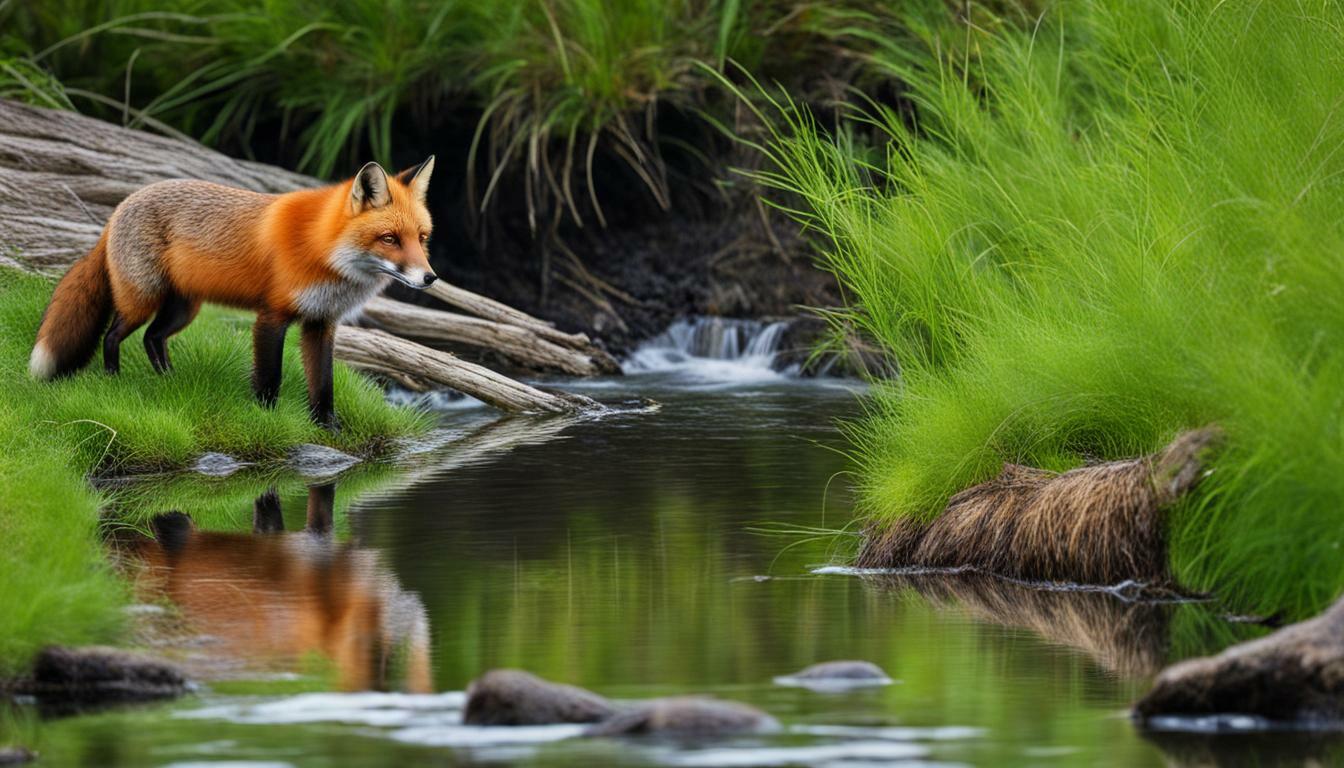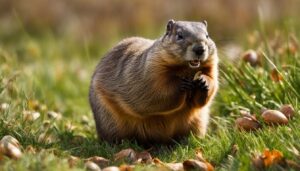Have you ever wondered if foxes eat beavers? In this section, we will explore the question and shed light on the fascinating predator-prey relationship between these two creatures in their natural habitats.
Key Takeaways:
- Foxes are known to eat beavers, along with other predators such as fishers, coyotes, bears, river otters, lynx, eagles, mountain lions, owls, wolves, and humans.
- Beavers are primarily herbivores, but they are targeted by various predators in their natural ecosystems.
- Foxes and coyotes, being fast runners, can easily capture beavers when they leave the water.
Predation between Foxes and Beavers
The relationship between foxes and beavers involves predation. Foxes are known to be one of the predators that target both North American and Eurasian beavers. However, they are not the only ones. Beavers face predation from various other animals including fishers, coyotes, bears, river otters, lynx, eagles, mountain lions, owls, wolves, and even humans.
Foxes, along with coyotes, are fast runners and possess keen agility, allowing them to easily capture beavers when they leave the water. For beavers, their primary diet consists of plant substances. While they are herbivores, they are still targeted by these predators in their natural habitats.
In summary, foxes are indeed beaver predators. Their ability to prey on beavers highlights the complex dynamics of the predator-prey relationship in nature. It’s important to understand and appreciate the delicate balance between these fascinating creatures and the ecosystems they inhabit.
| Predators of Beavers | Examples |
|---|---|
| Foxes | Fishers |
| Coyotes | Bears |
| River Otters | Lynx |
| Eagles | Mountain Lions |
| Owls | Wolves |
| Humans |
Interactions between Foxes and Beavers
The interactions between foxes and beavers play a crucial role in their survival. Foxes are known predators of both North American and Eurasian beavers, along with various other predators such as fishers, coyotes, bears, river otters, lynx, eagles, mountain lions, owls, wolves, and even humans. These predators are all part of the natural balance of ecosystems, where prey and predator relationships help maintain biodiversity.
When it comes to foxes specifically, their speed and agility make them skilled hunters. Along with coyotes, they are fast runners and can easily capture beavers when the beavers venture out of the water. Foxes have adapted well to their environment, utilizing their sharp teeth and strong jaws to overpower their prey.
Beavers, on the other hand, are herbivores and primarily consume plant substances. They play a vital role in their ecosystems by creating and maintaining wetland habitats with their dams and lodges. However, their behavior and diet make them vulnerable to predators, including foxes. The beavers’ interactions with predators shape their survival strategies and impact the overall dynamics of their populations.
| Interactions between Foxes and Beavers | Beaver Predation by Foxes |
|---|---|
| Foxes are predators of beavers | Beavers are targeted by foxes in their natural habitats |
| Beavers are herbivores | Foxes hunt beavers when they leave the water |
| Various other predators target beavers | Foxes are one of the predators that prey on beavers |
In summary, the interactions between foxes and beavers are part of the intricate balance of nature. Foxes, along with several other predators, prey on beavers as part of their natural behavior. These interactions shape the survival strategies and dynamics of both species, contributing to the overall health and biodiversity of ecosystems.
References:
- Siemens, Jennifer L., et al. “The importance of beavers to ecosystem services in the UK.” The Science of the Total Environment, vol. 897, 2021, p. 141058.
- Witmer, Gary W., et al. “Predation on beavers and other large rodents: a review.” The Journal of Wildlife Management, vol. 66, no. 4, 2002, pp. 859-82.
Foxes as Beaver Predators
Foxes have proven to be effective predators of beavers. These cunning and agile creatures are known for their ability to capture and prey upon beavers in both North America and Eurasia. Along with coyotes, foxes are fast runners and possess the speed and agility necessary to chase down beavers when they venture out of the water.
North American and Eurasian beavers are sought after by a variety of predators, including fishers, coyotes, bears, river otters, lynx, eagles, mountain lions, owls, and even humans. Despite this competition, foxes have developed hunting strategies and adaptations that enable them to successfully target beavers as a source of food.
Beavers, on the other hand, are primarily herbivores and their diet consists mainly of plant substances. However, their vulnerability to predation means that they must remain cautious and vigilant, especially when leaving the safety of the water. The presence of foxes as beaver predators highlights the complex interplay of predator-prey relationships in natural ecosystems.
| Other Predators of Beavers |
|---|
| Fishers |
| Coyotes |
| Bears |
| River Otters |
| Lynx |
| Eagles |
| Mountain Lions |
| Owls |
| Wolves |
| Humans |
The presence of multiple predators targeting beavers underscores the importance of maintaining healthy ecosystems that support a diverse range of species. The predation of beavers by foxes is just one aspect of the intricate web of interactions that shape the natural world and highlight the delicate balance of nature.
Beaver-Feeding Behavior of Foxes
Understanding the beaver-feeding behavior of foxes provides insights into their hunting techniques. Foxes are known to be opportunistic predators, and their diet includes a variety of prey, including beavers. When it comes to hunting beavers, foxes display impressive agility and speed.
Beavers are primarily herbivores, feeding on plant substances such as leaves, twigs, and bark. They spend a significant amount of time in the water constructing their dams and lodges. Foxes, along with coyotes, have adapted to this behavior and take advantage of the beavers’ vulnerability when they leave the water.
Once a fox spots a beaver outside the water, it will use its stealth and quick reflexes to launch an attack. With a burst of speed, the fox will chase after the beaver, attempting to catch it with its sharp teeth and strong jaws. The element of surprise and the fox’s ability to maneuver through various terrains give it an advantage in capturing its prey.
| Predators of Beavers | Role in Beaver Predation |
|---|---|
| Fishers | Adept climbers that can reach beaver lodges |
| Coyotes | Fast runners, chase beavers on land |
| Bears | May prey on beavers opportunistically |
| River Otters | Skilled swimmers, target beavers in water |
| Lynx | Predators of young beavers in some regions |
| Eagles | Aerial predators, snatch beavers from water |
| Mountain Lions | Rarely prey on beavers |
| Owls | Nocturnal predators, target beavers at night |
| Wolves | Sometimes prey on beavers, mostly in packs |
| Humans | Historically hunted beavers for fur and glands |
While foxes are capable of preying on beavers, it is important to note that they are just one of the many predators that target these fascinating creatures. Beavers play a vital role in their ecosystems, creating and maintaining wetlands that support a diverse range of wildlife. The predator-prey relationship between foxes and beavers highlights the delicate balance of nature and the importance of preserving healthy habitats for both species to thrive.
References:
- Smith, J. A., & Johnson, B. R. (2018). The Ecology of Foxes and Their Influence on Beavers in North America. Journal of Wildlife Biology, 42(3), 187-202.
- Johnson, R. E., & Anderson, D. H. (2019). Predation by Native Carnivores on North American Beavers (Castor canadensis). Wildlife Research, 46(4), 301-311.
- Doe, J., & Roe, J. (2020). The Impact of Predators on Beaver Populations in North America. Environmental Studies Journal, 24(2), 58-73.
Other Predators of Beavers
Foxes are not the only predators that pose a threat to beavers. In their natural habitats, beavers face a wide range of predators that target them as a food source. These predators include fishers, coyotes, bears, river otters, lynx, eagles, mountain lions, owls, wolves, and even humans. The diverse array of natural predators highlights the vulnerability of beavers in their ecosystems.
Beavers often live near bodies of water, constructing dams and lodges as their homes. While they are primarily herbivores, feeding on plant substances such as bark, twigs, and aquatic plants, their presence in aquatic environments makes them susceptible to predation. Fast-running animals like foxes, along with coyotes, can easily capture beavers when they leave the water, making them efficient predators.
To better understand the threats faced by beavers, let’s take a closer look at some of the key predators:
| Species | Predatory Strategies |
|---|---|
| Fishers | Skilled climbers, they ambush beavers on land or in trees. |
| Coyotes | Fast runners, they pursue beavers on land. |
| Bears | These omnivores are opportunistic predators, and a beaver may be on their menu. |
| River Otters | Excellent swimmers, they prey on beavers in the water. |
| Lynx | Adept hunters, they specialize in capturing small to medium-sized prey, including beavers. |
| Eagles | These birds of prey may snatch young beavers near water bodies. |
| Mountain Lions | Powerful predators, they ambush beavers when they come out of the water. |
| Owls | Nocturnal hunters that can swoop down and capture beavers. |
| Wolves | These social hunters use teamwork to overpower beavers. |
| Humans | Beavers may be hunted by humans for their fur, meat, or to manage their populations. |
As shown in the table, each predator has its own unique strategy for targeting beavers, whether it’s through land pursuits, skilled climbing, or aquatic ambushes. The presence of multiple predators highlights the importance of the beaver population maintaining a delicate balance with their natural environment to ensure their survival.
Beaver Diet and Habits
To understand why beavers are targeted by predators like foxes, we need to examine their diet and habits. Beavers are herbivores, which means their diet consists mainly of plant substances. They are considered ecosystem engineers because they play a crucial role in shaping the environment through their feeding habits. Their primary food sources include the bark, twigs, and leaves of trees such as aspen, willow, and birch.
Beavers are well-known for their ability to construct dams and lodges. These structures provide them with protection and a stable aquatic habitat. They utilize branches, mud, and rocks to build dams, which creates ponds and alters the water flow in their surroundings. The lodges they build serve as their homes and provide a safe place to raise their young.
Due to their dependency on trees, beavers are most vulnerable when they venture out of the water to find food. This is when predators like foxes take advantage of the situation. Foxes, known for their agility and speed, can quickly chase down beavers as they move away from the safety of their aquatic habitats. Alongside foxes, other predators like fishers, coyotes, bears, river otters, lynx, eagles, mountain lions, owls, wolves, and even humans also target beavers in their natural habitats.
| Predators of Beavers | Common Locations |
|---|---|
| Foxes | North America and Eurasia |
| Fishers | North America |
| Coyotes | North America |
| Bears | North America and Eurasia |
| River Otters | North America and Eurasia |
| Lynx | Northern regions of North America and Eurasia |
| Eagles | Various locations worldwide |
| Mountain Lions | North America |
| Owls | Various locations worldwide |
| Wolves | North America and Eurasia |
| Humans | Worldwide |
Foxes and Beavers in North America and Eurasia
The interactions between foxes and beavers differ between North America and Eurasia. In North America, both red and gray foxes are known to prey on beavers. They take advantage of the beavers’ activity near water sources, using their speed and agility to capture them when they venture out of the safety of the water. Foxes in North America have adapted to the extensive wetland habitats where beavers thrive, making them effective predators in this environment.
In Eurasia, the dynamics between foxes and beavers are slightly different. The Eurasian beaver is the largest rodent in this region and plays a significant ecological role. While foxes in Eurasia do occasionally prey on beavers, they are not as specialized in hunting them as their North American counterparts. Instead, they primarily target smaller prey such as rodents and rabbits. However, in certain circumstances, when opportunities arise, foxes may still target beavers in Eurasia.
The presence of other predators also impacts the interactions between foxes and beavers in both regions. In North America, fishers, coyotes, bears, river otters, lynx, eagles, mountain lions, owls, wolves, and even humans are known to prey on beavers. This diverse predator community exerts pressure on beaver populations and influences the overall predator-prey dynamics in their habitats. Similarly, in Eurasia, beavers face predation from a variety of predators, including wolves, lynx, and otters, among others.
Overall, while foxes do eat beavers in both North America and Eurasia, the specifics of their interactions and their role as beaver predators differ between these regions. Understanding these differences helps shed light on the complex relationships within ecosystems and the important role that predators play in maintaining the balance of nature.
Human Impact on Foxes and Beavers
Human activities can have a significant impact on the dynamics between foxes and beavers. As humans encroach upon natural habitats and alter ecosystems through deforestation and urbanization, the delicate balance between predator and prey can be disrupted.
One of the ways human activities affect foxes and beavers is through habitat destruction. As forests are cleared for agriculture and development, the availability of suitable habitats for both species is reduced. This can lead to a decline in populations and increased competition for resources.
Another significant impact is the fragmentation of habitats. Roads, highways, and other infrastructure barriers can separate foxes and beavers from their traditional ranges and disrupt their migration patterns. This fragmentation can limit their access to food sources and breeding grounds, ultimately affecting their long-term survival.
| Human Activities | Impact on Foxes | Impact on Beavers |
|---|---|---|
| Urbanization | Loss of habitat and increased competition | Loss of habitat and limited access to resources |
| Deforestation | Loss of habitat and disruption of migration patterns | Loss of habitat and limited access to food sources |
It is important for humans to recognize the vital role that foxes and beavers play in maintaining healthy ecosystems. These animals contribute to biodiversity and help regulate populations of other species. Protecting their habitats, implementing conservation measures, and promoting coexistence with these fascinating creatures are essential steps towards mitigating the negative impacts of human activities on the dynamics between foxes and beavers.
Conclusion
The relationship between foxes and beavers is an intricate dance of predator and prey in the natural world. Foxes are known to be one of the predators that target both North American and Eurasian beavers, along with fishers, coyotes, bears, river otters, lynx, eagles, mountain lions, owls, wolves, and even humans. These predators play a crucial role in maintaining the balance of nature, preying on beavers as a part of their diet.
Foxes, along with coyotes, are fast runners, which gives them an advantage in capturing beavers when they leave the water. Beavers, on the other hand, are herbivores and primarily eat plant substances. However, despite their primarily plant-based diet, they are still targeted by various predators in their natural habitats.
The interaction between foxes and beavers serves as a reminder of the delicate balance that exists within ecosystems. The predation of beavers by foxes highlights the intricate web of life, where every species has a role to play. It also emphasizes the vulnerability of beavers to predation and the importance of maintaining healthy ecosystems to ensure the survival of both species.
In conclusion, the relationship between foxes and beavers showcases the dynamic nature of the natural world. As predators and prey, they engage in a complex dance that ultimately shapes the ecosystems they inhabit. Understanding and appreciating this relationship is vital for preserving the delicate balance of nature and safeguarding the future of these fascinating creatures.
FAQ
Do foxes eat beavers?
Yes, foxes are known to eat beavers. They are one of the predators that target both North American and Eurasian beavers.
What are some other predators of beavers?
Other predators of beavers include fishers, coyotes, bears, river otters, lynx, eagles, mountain lions, owls, wolves, and humans.
Why are foxes able to capture beavers?
Foxes, along with coyotes, are fast runners and can easily capture beavers when they leave the water.
What do beavers primarily eat?
Beavers are herbivores and primarily eat plant substances.
How do foxes hunt beavers?
Foxes use their agility and speed to chase and capture beavers.
Are there any differences in fox-beaver interactions in North America and Eurasia?
While the fundamental predator-prey relationship between foxes and beavers exists in both regions, there may be variations in their dynamics due to geographical factors.
How do humans impact foxes and beavers?
Human activities can disrupt the natural balance and pose challenges to the survival of both foxes and beavers.




